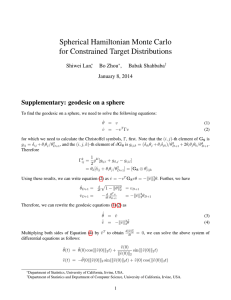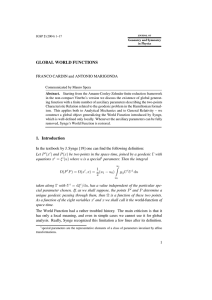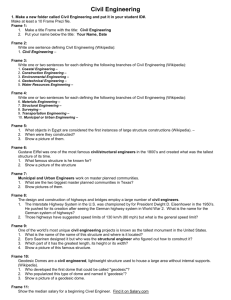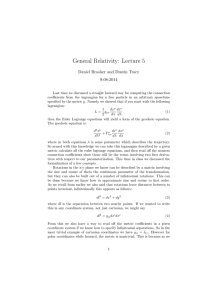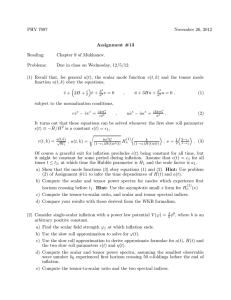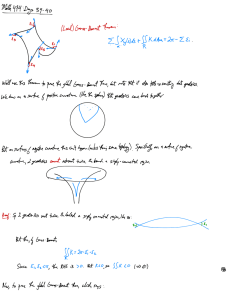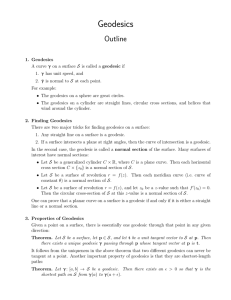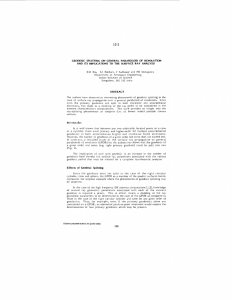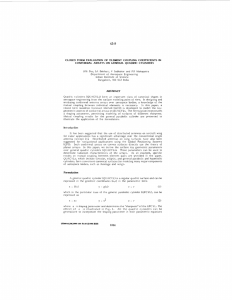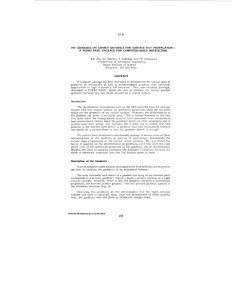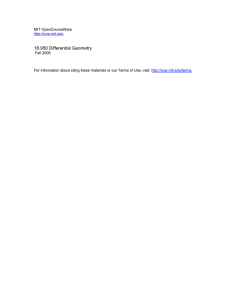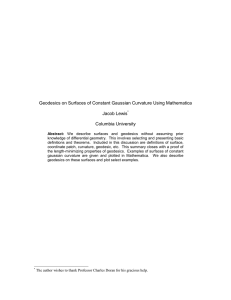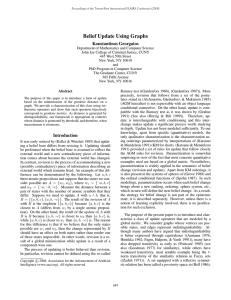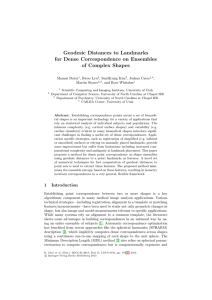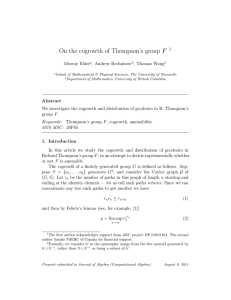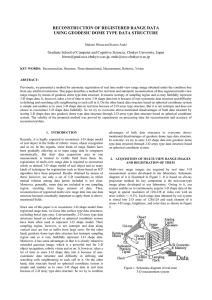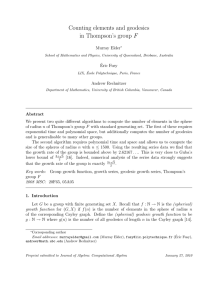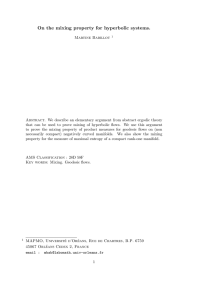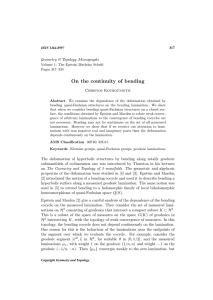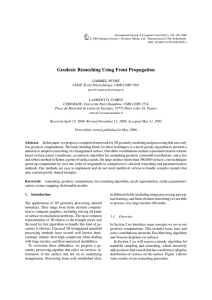Physics 5040 Spring 2009 Problem Set 2
advertisement
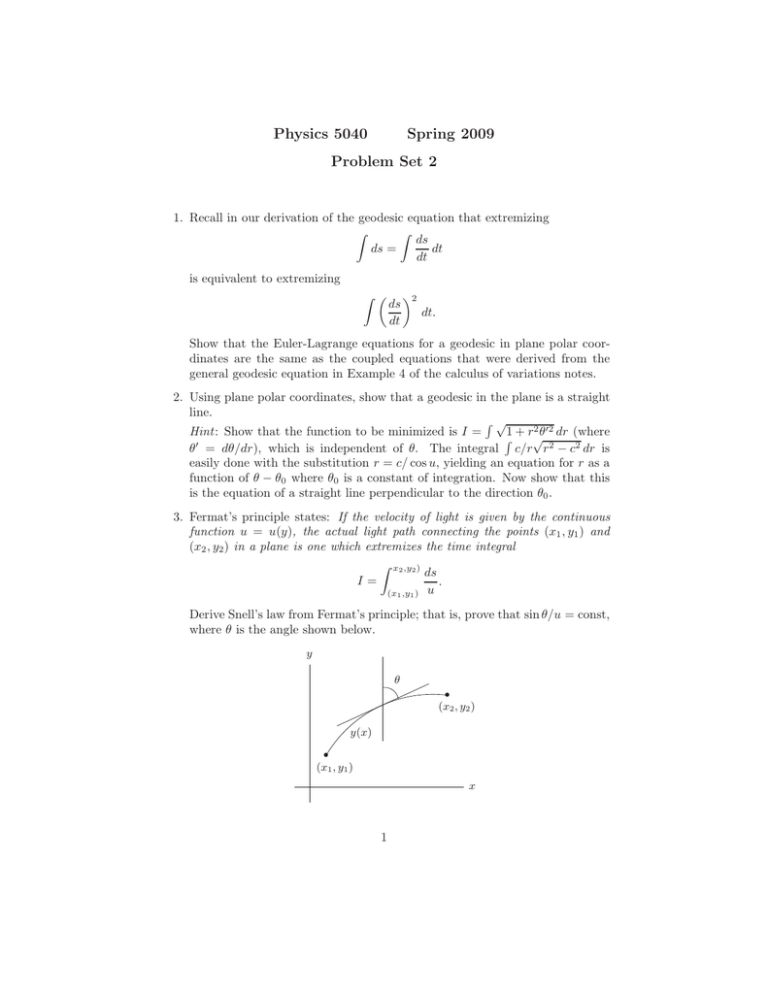
Physics 5040 Spring 2009 Problem Set 2 1. Recall in our derivation of the geodesic equation that extremizing Z Z ds dt ds = dt is equivalent to extremizing Z ds dt 2 dt. Show that the Euler-Lagrange equations for a geodesic in plane polar coordinates are the same as the coupled equations that were derived from the general geodesic equation in Example 4 of the calculus of variations notes. 2. Using plane polar coordinates, show that a geodesic in the plane is a straight line. R√ 2 θ ′2 dr (where 1 + r√ Hint : Show that the function to be minimized is I = R ′ θ = dθ/dr), which is independent of θ. The integral c/r r2 − c2 dr is easily done with the substitution r = c/ cos u, yielding an equation for r as a function of θ − θ0 where θ0 is a constant of integration. Now show that this is the equation of a straight line perpendicular to the direction θ0 . 3. Fermat’s principle states: If the velocity of light is given by the continuous function u = u(y), the actual light path connecting the points (x1 , y1 ) and (x2 , y2 ) in a plane is one which extremizes the time integral Z x2 ,y2 ) ds I= . (x1 ,y1 ) u Derive Snell’s law from Fermat’s principle; that is, prove that sin θ/u = const, where θ is the angle shown below. y θ • (x2 , y2 ) y(x) • (x1 , y1 ) x 1 Hint : Use the second form of Euler’s equation (equation 14 in the notes). 4. We have seen that the geodesic equation is j i d2 xl l dx dx + Γ = 0. ij dt2 dt dt Show that under a change of parameter t → σ = f (t) the geodesic equation becomes j i f¨ dxl d2 xl l dx dx + Γ = − . ij dσ 2 dσ dσ f˙2 dσ Thus the geodesic equation retains its form only under affine changes of parameter t → f (t) = at + b. 5. Show that the geodesic equation implies that the quantity gij dxi dxj dt dt is a constant along the geodesic, i.e., dxi dxj d gij = 0. dt dt dt Hint : Don’t forget to use the geodesic equation. Also recall the formula for the Christoffel symbols ∂gki ∂gij 1 lk ∂gkj l . + − Γij = g 2 ∂xi ∂xj ∂xk 6. Using the geodesic equation, show that the geodesics on the surface of a sphere in R3 are great circles. 7. (a) Using the notation of Section 7 of the calculus of variations notes, suppose that we want to extremize the functional Z t1 ˙ x̃, ¨ t) dt f (x̃, x̃, I(ε) = t0 where all other conditions (such as fixed end points and the continuity of derivatives) are as in the notes. Derive the Euler-Lagrange equation for f . Be sure to clearly state any additional boundary conditions you need to specify in order to obtain your result. (b) Find the equation of motion of a particle described by the Lagrangian L=− What motion does this describe? 2 k m q q̈ − q 2 . 2 2 8. The parametrized equation of a circular helix of radius ρ in R3 is of the form x(t) = (ρ cos ωt, ρ sin ωt, kt). Show that the geodesics on the surface of a right circular cylinder of radius ρ oriented along the z-axis in R3 are portions of a helix. 9. Let F [y] be the functional F [y] = Z sin y(x) dx . y(x) Using the definition F [y(x) + εδ(x − x0 )] − F [y] δF [y] = lim δy(x0 ) ε→0 ε find δF [y] . δy(x0 ) 10. (a) In Example 10 of the notes it is shown that as a consequence of Green’s theorem, the area enclosed by a simple closed curve is given by Z 1 A= (xẏ − ẋy) dt. 2 Show by changing to plane polar coordinates that this is the same as Z 1 r2 dθ. A= 2 (b) Inverse Isoperimetric Problem (“isoareametric” problem). Prove that of all simple closed curves enclosing a given area A, the least perimeter is possessed by the circle. What is the value of the Lagrange multiplier λ in terms of A? 11. Suppose you have a string of length l with one end fixed at the origin of the xy-plane, and the other end on the x-axis such that the area enclosed between the string and the x-axis is a maximum. Show that the shape of the string is a semicircle. R Hint : From elementary calculus the area is given by y dx. Show that this is Rl p the same as 0 y 1 − y ′2 ds where s is the distance along the string starting at the origin, and y ′ = dy/ds. Use the second form of Euler’s equation to find y as a function of s. Now use this to find x as a function of s, and then combine these equations for x and y to eliminate s. 12. Find the dimensions of the parallelepiped of maximum volume inscribed in a sphere of radius R. 3

